View in other NatureServe Network Field Guides
NatureServe
Montana
Utah
Wyoming
Idaho
Wisconsin
British Columbia
South Carolina
Yukon
California
New York
Flathead Chub - Platygobio gracilis
Native Species
Global Rank:
G5
State Rank:
S4
(see State Rank Reason below)
Agency Status
USFWS:
USFS:
BLM:
External Links
State Rank Reason (see State Rank above)
Species is common and widespread but faces same threats from altered hydrology of natural systems and may be declining in parts of its range
General Description
The flathead chub has one of the greatest north-south distributions of any of the minnows. It extends from New Mexico to the northern Yukon Territory in Canada. Here in Montana it is found in the plains and foothill streams of our Missouri-Yellowstone River complex and is an indicator species of the Medium Warmwater River Fish Assemblage. Its most conspicuous features are a barbel or "whisker" at each corner of its mouth, flattened head and streamlined appearance. The sleek body shape and pointed fins are believed to be adaptations for living in fast water. Flathead chubs grow to about 12 inches in length and are sometimes used as bait. They are often caught by anglers.
Diagnostic Characteristics
Very silvery, shading to brown or dusky on back. Mouth large with a conspicuous barbel at each corner. Pectoral fin sickle shaped with long, sharply pointed tip that may extend almost to front of pelvic fin.
Species Range
Montana Range
Range Descriptions
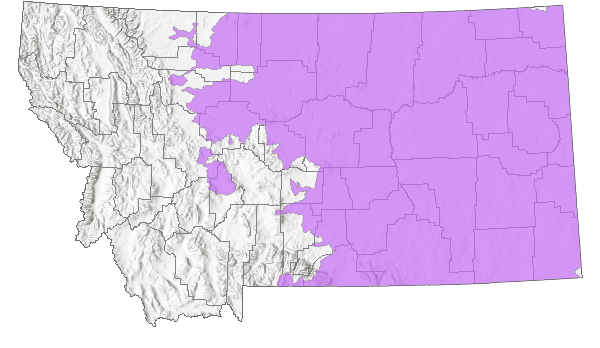
 Native
Native
Western Hemisphere Range
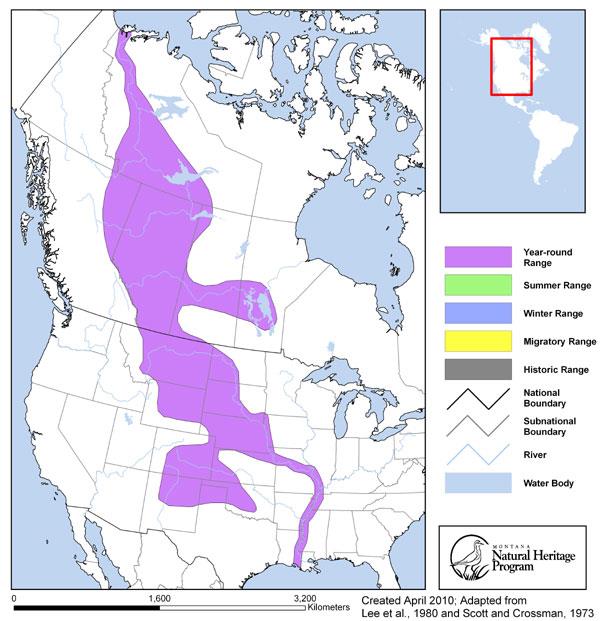
Range Comments
In Montana, the linear distance of streams and rivers occupied by the flathead chub is between 10,000-20,000 km (6,000-12,500 miles). Linear range was calculated to be a conservative 10,961 km (6850 river miles) of actual documented occupied streams to a more liberal river extent of >12,400 km (8,000 miles) based on MFISH river miles calculations associated with surveys, this was calculated for the Nature Serve Species ranking in 2012.
Observations in Montana Natural Heritage Program Database
Number of Observations: 1577
(Click on the following maps and charts to see full sized version)
Map Help and Descriptions
Relative Density
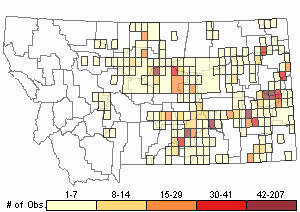
Recency
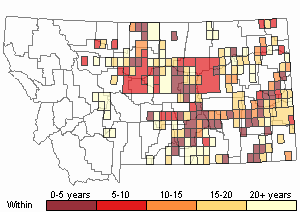
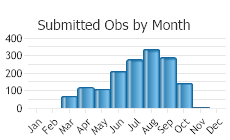
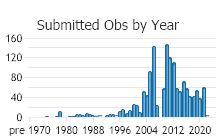
 (Observations spanning multiple months or years are excluded from time charts)
(Observations spanning multiple months or years are excluded from time charts)
Migration
Makes spawning run to lower Marias River.
Habitat
Plains rivers and streams with some to moderate turbidity. Many reaches of prairie streams and rivers have the characteristic riffle/run/pool habitat and gravels preferred by flathead chubs. Studies on middle Missouri River showed it was relatively more abundant in the lower gradient downstream sections.
Food Habits
Eats mostly aquatic invertebrates of all sorts but includes some vegetation. Heavy seasonal use of terrestrial insects.
Ecology
Were most common in main channel border and side channel chute. Habitat types on middle Missouri River. Commonly found in both riffles and pools.
Reproductive Characteristics
Sexually mature at 2 years. Probably spawns during July. Middle Missouri River study showed spawning from mid June to latter half of July with peak in early July.
Stewardship Responsibility
References
- Literature Cited AboveLegend:
 View Online Publication
View Online Publication Lee, D.S., C.R. Gilbert, C.H. Hocutt, R.E. Jenkins, D. E. McAllister, J. R. Stauffer, Jr. 1980. Atlas of North American freshwater fishes. North Carolina State Musuem of Natural History. 867 p.
Lee, D.S., C.R. Gilbert, C.H. Hocutt, R.E. Jenkins, D. E. McAllister, J. R. Stauffer, Jr. 1980. Atlas of North American freshwater fishes. North Carolina State Musuem of Natural History. 867 p. Scott, W.B. and E.J. Crossman. 1973. Rainbow trout, Kamloops trout, Steelhead trout Salmo gairdneri Richardson. pp. 184-191. In: Freshwater fishes of Canada. Ottawa, Canada: Fisheries Research Board of Canada, Bulletin 184. 966 p.
Scott, W.B. and E.J. Crossman. 1973. Rainbow trout, Kamloops trout, Steelhead trout Salmo gairdneri Richardson. pp. 184-191. In: Freshwater fishes of Canada. Ottawa, Canada: Fisheries Research Board of Canada, Bulletin 184. 966 p.
- Additional ReferencesLegend:
 View Online Publication
View Online Publication
Do you know of a citation we're missing? Barfoot, C.A. 1993. Longitudinal distribution of fishes and habitat in Little Beaver Creek, Montana. M.Sc. Thesis. Bozeman, MT: Montana State University. 66 p.
Barfoot, C.A. 1993. Longitudinal distribution of fishes and habitat in Little Beaver Creek, Montana. M.Sc. Thesis. Bozeman, MT: Montana State University. 66 p. Barfoot, C.A. and R.G. White. 1999. Fish assemblages and habitat relationships in a small northern Great Plains stream. The Prairie Naturalist 31(2):87-107.
Barfoot, C.A. and R.G. White. 1999. Fish assemblages and habitat relationships in a small northern Great Plains stream. The Prairie Naturalist 31(2):87-107. Bramblett, R.G. 1996. Habitats and movements of pallid and shovelnose sturgeon in the Yellowstone and Missouri Rivers, Montana and North Dakota. Ph.D. Dissertation. Bozeman, MT: Montana State University. 210 p.
Bramblett, R.G. 1996. Habitats and movements of pallid and shovelnose sturgeon in the Yellowstone and Missouri Rivers, Montana and North Dakota. Ph.D. Dissertation. Bozeman, MT: Montana State University. 210 p. Clancey, C.G. 1978. The fish and aquatic invertebrates in Sarpy Creek, Montana. M.Sc. Thesis. Bozeman, MT: Montana State University. 54 p.
Clancey, C.G. 1978. The fish and aquatic invertebrates in Sarpy Creek, Montana. M.Sc. Thesis. Bozeman, MT: Montana State University. 54 p. Craig, V.E. 1952. A story of fish production as it applies to Montana. M.Sc. Thesis. Bozeman, MT: Montana State University. 92 p.
Craig, V.E. 1952. A story of fish production as it applies to Montana. M.Sc. Thesis. Bozeman, MT: Montana State University. 92 p. Dieterman, D.J., M.P. Ruggles, M.L. Wildhaber, and D.L. Galat (eds). 1996. Population structure and habitat use of benthic fishes along the Missouri and Lower Yellowstone Rivers. 1996 Annual report of Missouri River Benthic Fish Study PD-95-5832 to U.S. Army Corps of Engineers and U.S. Bureau of Reclamation. 238 p.
Dieterman, D.J., M.P. Ruggles, M.L. Wildhaber, and D.L. Galat (eds). 1996. Population structure and habitat use of benthic fishes along the Missouri and Lower Yellowstone Rivers. 1996 Annual report of Missouri River Benthic Fish Study PD-95-5832 to U.S. Army Corps of Engineers and U.S. Bureau of Reclamation. 238 p. Duncan, M.B. 2019. Distributions, abundances, and movements of small, nongame fishes in a large Great Plains river network. Ph.D. Dissertation. Bozeman, MT: Montana State University. 255 p.
Duncan, M.B. 2019. Distributions, abundances, and movements of small, nongame fishes in a large Great Plains river network. Ph.D. Dissertation. Bozeman, MT: Montana State University. 255 p. Hendricks, P., S. Lenard, D.M. Stagliano, and B.A. Maxell. 2013. Baseline nongame wildlife surveys on the Fort Peck Indian Reservation. Report to the Assiniboine and Sioux Tribes of the Fort Peck Indian Reservation. Montana Natural Heritage Program, Helena, MT. 83 p.
Hendricks, P., S. Lenard, D.M. Stagliano, and B.A. Maxell. 2013. Baseline nongame wildlife surveys on the Fort Peck Indian Reservation. Report to the Assiniboine and Sioux Tribes of the Fort Peck Indian Reservation. Montana Natural Heritage Program, Helena, MT. 83 p. Joslin, Gayle, and Heidi B. Youmans. 1999. Effects of recreation on Rocky Mountain wildlife: a review for Montana. [Montana]: Montana Chapter of the Wildlife Society.
Joslin, Gayle, and Heidi B. Youmans. 1999. Effects of recreation on Rocky Mountain wildlife: a review for Montana. [Montana]: Montana Chapter of the Wildlife Society. Montana Fish, Wildlife and Parks. 1989. Hauser Reservoir fisheries management plan: September 1989-September 1994. 16 p.
Montana Fish, Wildlife and Parks. 1989. Hauser Reservoir fisheries management plan: September 1989-September 1994. 16 p. Mullen, J.A. 2007. Spatiotemporal variation of fish assemblages in Montana prairie streams. M.Sc. Thesis. Bozeman, MT: Montana State University. 102 p.
Mullen, J.A. 2007. Spatiotemporal variation of fish assemblages in Montana prairie streams. M.Sc. Thesis. Bozeman, MT: Montana State University. 102 p. Mullins, M.S. 1991. Biology and predator use of cisco (Coregonus artedi) in Fort Peck Reservoir, Montana. M.Sc. Thesis. Bozeman, MT: Montana State University. 68 p.
Mullins, M.S. 1991. Biology and predator use of cisco (Coregonus artedi) in Fort Peck Reservoir, Montana. M.Sc. Thesis. Bozeman, MT: Montana State University. 68 p. Olund, L.J. And F.B. Cross. 1961. Geographic variation in the North American Cyprinid fish, Hybopsis gracilis. Pp. 325-348 In: Hall, E.R., H.S. Fitch, and R.W. Wilson (eds). Lawrence, KS: University of Kansas Publications, Museum of Natural History 13(7).
Olund, L.J. And F.B. Cross. 1961. Geographic variation in the North American Cyprinid fish, Hybopsis gracilis. Pp. 325-348 In: Hall, E.R., H.S. Fitch, and R.W. Wilson (eds). Lawrence, KS: University of Kansas Publications, Museum of Natural History 13(7). Penkal, R.F. 1977. Black bass populations of the Tongue River Reservoir, Montana. M.Sc. Thesis. Bozeman, MT: Montana State University. 111 p.
Penkal, R.F. 1977. Black bass populations of the Tongue River Reservoir, Montana. M.Sc. Thesis. Bozeman, MT: Montana State University. 111 p. Rosenthal, L.R. 2007. Evaluation of distribution and fish passage in relation to road culverts in two eastern Montana prairie streams. M.Sc. Thesis. Bozeman, MT: Montana State University. 78 p.
Rosenthal, L.R. 2007. Evaluation of distribution and fish passage in relation to road culverts in two eastern Montana prairie streams. M.Sc. Thesis. Bozeman, MT: Montana State University. 78 p. Sanborn, B.W. 1990. The ecology of Rainbow Trout in the Bighorn River, Montana. M.Sc. Thesis. Bozeman, Montana: Montana State University. 63 p.
Sanborn, B.W. 1990. The ecology of Rainbow Trout in the Bighorn River, Montana. M.Sc. Thesis. Bozeman, Montana: Montana State University. 63 p. Scarnecchia, D.L., K. Grabenstein, and S. Hiebert. 2000. Biology of the Flathead chub in the lower Yellowstone River, Montana. Intermountain Journal of Sciences 6(1):10-17.
Scarnecchia, D.L., K. Grabenstein, and S. Hiebert. 2000. Biology of the Flathead chub in the lower Yellowstone River, Montana. Intermountain Journal of Sciences 6(1):10-17. Stash, S.W. 2001. Distribution, relative abundance, and habitat associations of Milk River fishes related to irrigation diversion dams. M.Sc. Thesis. Bozeman, MT: Montana State University. 82 p.
Stash, S.W. 2001. Distribution, relative abundance, and habitat associations of Milk River fishes related to irrigation diversion dams. M.Sc. Thesis. Bozeman, MT: Montana State University. 82 p. Stevenson, H.R. 1975. The trout fishery of the Bighorn River below Yellowtail Dam, Montana. M.Sc. Thesis. Bozeman, MT: Montana State University. 67 p.
Stevenson, H.R. 1975. The trout fishery of the Bighorn River below Yellowtail Dam, Montana. M.Sc. Thesis. Bozeman, MT: Montana State University. 67 p. Stringer, A.L. 2018. Status of Northern Pearl Dace and chrosomid dace in prairie streams of Montana. M.Sc. Thesis. Bozeman, MT: Montana State University. 150 p.
Stringer, A.L. 2018. Status of Northern Pearl Dace and chrosomid dace in prairie streams of Montana. M.Sc. Thesis. Bozeman, MT: Montana State University. 150 p. Trenka, R.J. 2000. Community structure and habitat associations of fishes of the lower Tongue and Powder Rivers. M.Sc. Thesis. Bozeman, MT: Montana State University. 85 p.
Trenka, R.J. 2000. Community structure and habitat associations of fishes of the lower Tongue and Powder Rivers. M.Sc. Thesis. Bozeman, MT: Montana State University. 85 p. Werdon, S.J. 1992. Population status and characteristics of Macrhybopsis gelida, Platygobio gracilis and Rhinichthys cataractae in the Missouri River Basin. Masters thesis. South Dakota State University, Brookings, SD. 55 pp.
Werdon, S.J. 1992. Population status and characteristics of Macrhybopsis gelida, Platygobio gracilis and Rhinichthys cataractae in the Missouri River Basin. Masters thesis. South Dakota State University, Brookings, SD. 55 pp. Wuellner, M.R. 2007. Influence of reach and watershed characteristics on fish distributions in small streams of eastern Montana. M.Sc. Thesis. Bozeman, MT: Montana State University. 80 p.
Wuellner, M.R. 2007. Influence of reach and watershed characteristics on fish distributions in small streams of eastern Montana. M.Sc. Thesis. Bozeman, MT: Montana State University. 80 p. Young, B.A., T.L. Welker, M.L. Wildhaber, C.R. Berry, and D. Scarnecchia (eds). 1997. Population structure and habitat use of benthic fishes along the Missouri and Lower Yellowstone Rivers. 1997 Annual report of Missouri River Benthic Fish Study PD-95-5832 to U.S. Army Corps of Engineers and U.S. Bureau of Reclamation. 207 p.
Young, B.A., T.L. Welker, M.L. Wildhaber, C.R. Berry, and D. Scarnecchia (eds). 1997. Population structure and habitat use of benthic fishes along the Missouri and Lower Yellowstone Rivers. 1997 Annual report of Missouri River Benthic Fish Study PD-95-5832 to U.S. Army Corps of Engineers and U.S. Bureau of Reclamation. 207 p.
- Web Search Engines for Articles on "Flathead Chub"
- Additional Sources of Information Related to "Fish"





